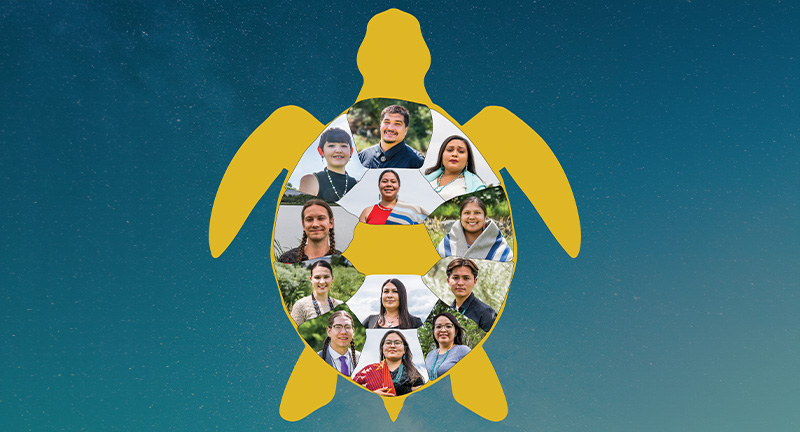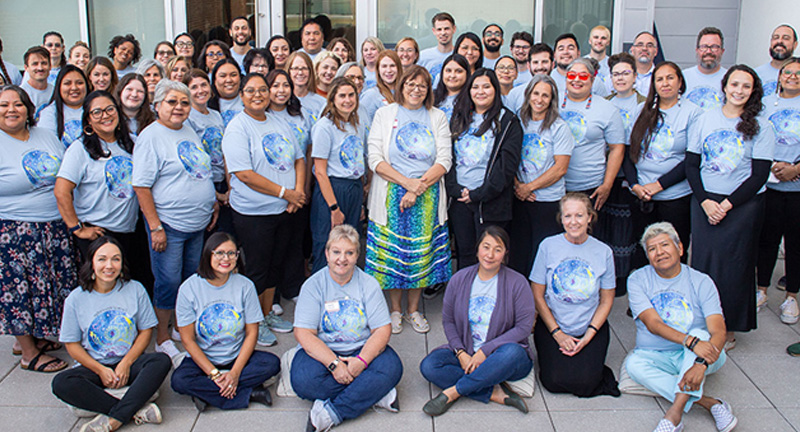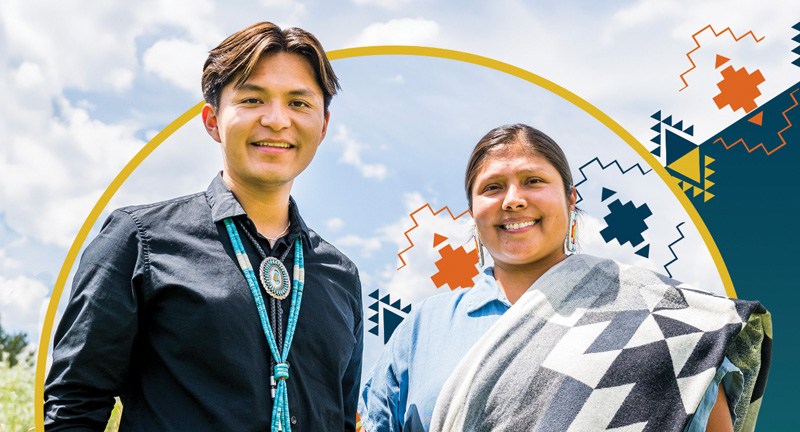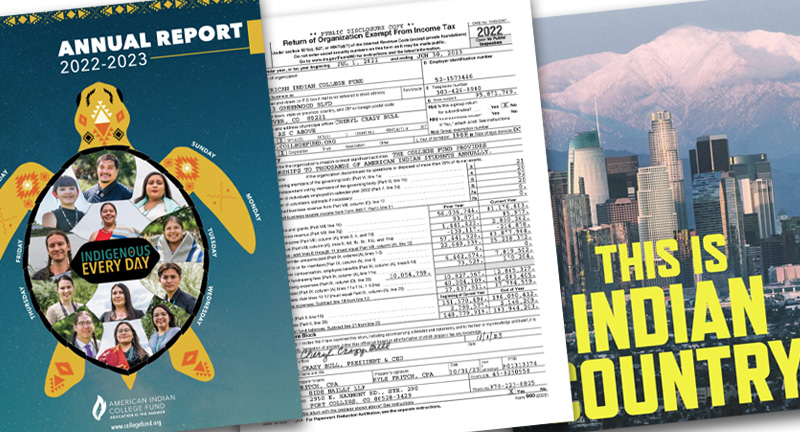Explore these tips to learn how to strengthen your scholarship application and find answers to common application questions.
Short-Answer Questions
Formatting & Editing
Profile vs. Application
Application Photos
Proving Descent
Exploring Extracurricular Activities
Updating Application Information
Returning Scholars: What to Update?
Full Circle Scoring Insights
Short-Answer Questions
The Full Circle and TCU Scholarship applications have an essay style format with three short-answer questions.
These sections are your chance to share your story and give readers an opportunity to see how a scholarship would help you achieve your stated educational and professional goals and require you to discuss three elements: an obstacle that you have overcome in order to get to where you are now; your educational goals and how this scholarship will help you achieve those; and how your education will help your Native community.
We recommend that you type out your responses to the short-answer question in a Word document (like this template) to ensure safe keeping if you need to abandon the application before submission.
To enhance this section, start by creating an outline of your thoughts and initial answers to each question. The outline does not need to look perfect, but it will allow you to start thinking about and organizing these questions and how they relate to each other.
Here are two sample outlines to help get you started:
- A Visual Outline for those who prefer to see the outline as part of the big picture.
- A Textual Outline for those who prefer a more linear approach.
Whichever outline you choose, remember that they are not meant to be exhaustive. They are designed to help you organize your thoughts and begin planning for writing your final responses. There is no right or wrong answer for these questions, but it is very important that you provide a thorough response to each short-answer question.
As always, don’t forget to check your grammar and spelling!
NOTE: The short-answer section is ONLY available in the application, not in the profile. This means you must have all of your application ready (INCLUDING YOUR TRANSCRIPT READY TO UPLOAD) when you answer these questions; otherwise your answers will not be saved.
Formatting & Editing
Now that you have outlined your responses and completed the first draft, you can celebrate the next step with these tips for formatting, editing, and proofreading to make sure your application is PREPPED for excellence.
We frequently receive formatting and style questions from students about the scholarship application’s short-answer questions. While we do not require applicants to use any specific style, such as APA or MLA, our readers do expect you to follow basic essay formatting. This includes, but is not limited to, the following:
• Writing in complete sentences.
• Creating appropriate paragraphs.
• Ensuring that answers flow cohesively.
Do not answer the short-answer questions with bullet points or fragments. For example, if your educational goal is to complete a bachelor’s degree in early childhood education and teach on your reservation, it is not recommended to format your answer like this:
- Educational Goals: B.A. in early childhood education, plan to teach on the reservation
Instead, use full sentences and allow your personality and passions to come forward, like this:
It is my dream to complete my bachelor’s degree in early childhood education in order to teach the next generation of leaders on my reservation. I believe that foundational life skills can be taught at a young age, and I want to be a part of empowering these learners through my degree.
Once you have typed out your three responses, the real fun can begin. With a solid edit and thorough proofreading process, you will be amazed at how polished your application becomes.
Proven tips to ensure a successful editing process can be easily remembered by being PREPPED.
PREPPED stands for Passion, Readability, Every Question, Punctuation and Grammar, Printout Spellcheck, Examples, and Double Take. Here’s how to be PREPPED to finish final touch-ups and tweaks to make it your best essay yet:
- Passion: Read over your words and ask yourself if your passions are evident in your writing. Are you writing something because you think it is what the readers want to hear or are you genuinely passionate about your goals and dreams?
- Readability: Do your answers flow? Are the sentences and thoughts laid out in a cohesive way that leads the reader through your answer from start to finish? Are there any parts that sound awkward or out-of-place? Are they necessary and if so, where could they be better situated?
- Every Question: Did your short answer completely address the question?
- Punctuation and Grammar: Is your grammar on track? Did you place commas in the correct spots? Do your possessive nouns include the apostrophe properly? Have you used the correct form of commonly misused words, such as they, they’re, their, and affect and effect?
- Printout Spellcheck: To avoid submitting an essay that says “Richard is my best fried,” as even Microsoft Word’s Spellcheck will not catch that error, print out a copy of your answers and perform a manual spellcheck. In addition, read your work out loud. You will be surprised how many grammar, punctuation, and spelling mistakes you can catch that way!
- Examples: Did you provide specific examples to better explain your statements? Are these examples relevant to the question and the point you are trying to make? Do they make sense in the context of your answer?
- Double Take: Now that you have gone through the finer details of editing and proofreading, ask a friend, instructor, tutor, or family member to read through your responses. Ask them to use the PREPPED checklist. Once they have read them over and provided feedback, edit your answers once more to reflect any changes. Then go through this checklist one last time.
Profile vs. Application
“…You mean I didn’t submit my application? But I filled out everything!”
“Aren’t there supposed to be short-answer questions somewhere? I’ve filled out the entire profile and don’t see them!”
“Where do I attach my transcript? Why isn’t it showing up?”
If you’ve ever asked or heard any of these questions, then you are engaged in the epic battle of Profile vs. Application confusion. This struggle occurs when these sections are not understood as separate two parts of application process.
The following series of screenshots will help you in every step of the process; from signing in through submission. Pay close attention, as important details like saving your work are also included.
Profile:
The profile is the first thing you see when signing into the online application. There are four sections under your profile. They are “Basic Info,” “Documents”, “Address,” and “Application Information.” Don’t be fooled! Finishing this section and clicking “Save” does NOT SUBMIT YOUR APPLICATION.
Here are examples of each section of the profile:


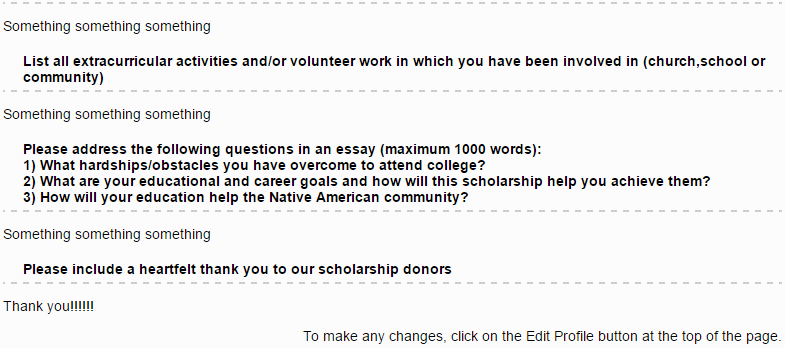

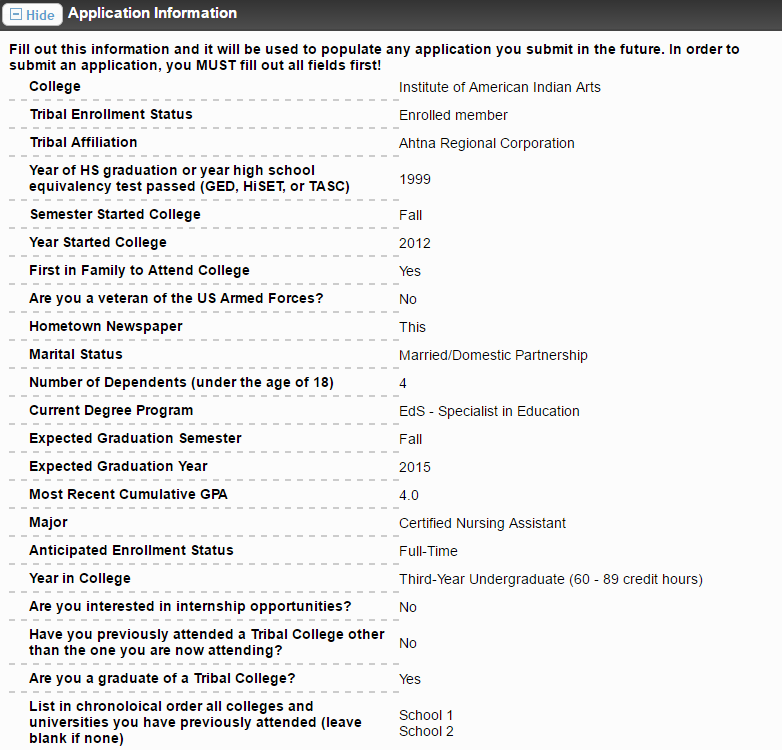
Once again, finishing this section and clicking “Save” does NOT SUBMIT YOUR APPLICATION.
Application:
Once you’ve filled out everything in the profile (or updated it, as a returning applicant) and clicked “Save,” you will be taken to this screen:

Click on the appropriate application you wish to complete. (Note that if you are not a tribal college student, only the Full Circle application option will be available.)
In the application, you will see your profile information again. If the information is correct, select “Next Step in Submit Application Process” at the bottom right of the screen.
![]()
The final page confirms your field of study and other information and allows you to paste your responses to the short-answer questions. A template for the short-answer questions is available for download here. In addition, you are prompted to upload your transcript (for the Full Circle application).
It is only here that you will find the short-answer questions and the option to upload your transcript.
You are now ready to select “Submit Application.” Congratulations!
![]()
Remember, “Save” and “Submit” are not the same. You SAVE your profile if you are not ready to complete the application process. You SUBMIT your application. If you have not done both then you did not submit your application correctly.
Finally, you should receive a confirmation email once you’ve successfully submitted. If you do not receive an email (and you’ve checked your spam and junk folders), then your application was not submitted correctly and you should contact us immediately.
Application Photos
The College Fund uses student application photos in donor reports, direct mail appeals to supporters, and on our website to inspire more supporters to give; therefore, it is critical to present yourself in a way that portrays you in a positive light to donors. Upload a new photograph to submit alongside your application each year.
- Your photo should depict you in a professional light. Your face should be clearly visible (avoid ball caps, sunglasses, or heavily pixilated or dark images).
- Your photo should be a headshot, depicting you from the neck up; however, a family photo is also acceptable.
- Traditional regalia is encouraged but not required.
- While digital cameras produce higher-quality images, we understand that not everyone has access to one. When using your phone, have someone else take the photo (no selfies). Make sure the photographer is close enough that the photo doesn’t need to be cropped; this will help avoid potential image quality issues. Most tribal colleges have a camera in the financial office.
- Try to take the photo outdoors for better lighting. The subject (you) should face the light source or take a quarter turn to the light source. The photographer should never face the light source (this will help avoid silhouetting, which results in darkening of the subject). Using a light source like a window or a strong light in front of you is ideal. Blankets and other backdrops can add interest to your photo. If you are taking a photo against a wall, stand at least four feet away from the wall and focus on your face. Avoid using a computer to take a photo, as it can cause photo discoloration.
- Don’t forget to SMILE! Make sure your face is in focus and you are not in a side profile pose. Try to fill the frame with the most important part of the photo, YOU. The scenery may be nice, but remember, we want to see your faces and show the donors who you are.
Proving Descent
For students who are not enrolled tribal members themselves but are able to prove that their parents or grandparents have tribal enrollment, the following is very important.
The graphic below illustrates an excellent example of how to prove descent through a paper trail:

Examples of tribal documents may include:
– Official letter from the tribe stating the enrollment status of the parent and/or grandparent;
– A copy of the Tribal ID card;
– CIB (Certificate of Indian Blood)
Where can I find out my ancestry? Who do I contact?
See the U.S. Department of the Interior’s Trace Indian Ancestry page. The page includes resources and information to help guide readers to appropriate offices or organizations that can assist in tracing ancestry. We do not have any contact information for tribal enrollment offices, but many, if not all, can be located through an internet search.
It might take time and effort to compile the necessary documents, but remember that the time is well spent if it leads to scholarship funding!
Exploring Extracurricular Activities
Note: This application tip is a response to the extracurricular activities segment of the College Fund’s Full Circle and TCU Scholarship Program applications. However, the information found in this tip may apply to scholarship applications in general.
Sports teams or clubs are the first that come to mind when thinking of extracurricular activities. While these are indeed prime examples to include in your scholarship application, they are not the only ones.
It is important to think about the background of this question. Application readers are looking for ways that you have demonstrated participation and leadership in your school, community, and/or tribe. Readers want to see that you are engaged and involved in these areas.
Don’t be discouraged if you do not have time for sports or a dozen bake sales. To avoid getting caught in a rut of sports- or student-government-only types of extracurricular activities, explore these topics instead:
– Arts (theatre, photography, etc.)
– Church Activity
– Clubs (in school or in the community)
– Community Activity
– Hobbies
– Media (web work, school newspaper, etc.)
– Military (ROTC, drill team, etc.)
– Music
– Volunteer Work/Community Service
– Employment
Remember, this section is designed for you to show your community participation and leadership. Be creative and thorough, and let your story shine!
Updating Application Information
The requirements for the various scholarship programs your application will be considered for include but are not limited to major, geographic location, GPA, degree type, college attended, marital status, and number of dependents. Therefore, keeping your application information up to date may determine your eligibility for funding.
Profile versus application:
Your eligibility for scholarships is based on the information provided in the application (not the profile).
- You can update your profile in our online application system at any time, which is different than updating your application.
- Once you submit an application, you are no longer able to edit it.
So what happens if you submit an application for the Full Circle scholarship program while you’re attending Northern Arizona University and decide to transfer to the College of the Muscogee Nation before the semester begins? Do you simply update your profile and hope that we will notice the change when we start the awarding process?
Unfortunately, that’s not how it works.
You MUST contact a member of the Student Success Services team to assist you if any of the following circumstances apply:
- You have transferred schools (even if it’s from one tribal college to another).
• You have changed your major and/or degree program.
• Your anticipated graduation date has changed (whether you’re graduating early or have decided to add a minor and will be in school longer, we need to know because either could affect your eligibility for certain scholarships).
• You are a high school student and submitted the application under a different college name than the one you’ve decided to attend.
Remember, accurate and up-to-date information in your application allows the College Fund to determine your eligibility for a variety of scholarship opportunities, so it is vital to ensure that your scholarship applications are updated!
Returning Scholars: What to Update?
First-time applicants are excused from reading this application tip.
For returning scholars this is important. Every year we are asked about updating information as you re-submit your Full Circle and TCU applications.
Your application must be updated every time you apply. While some updates are non-negotiable (such as “Most Recent Cumulative GPA”), others need only to be updated when circumstances have changed. Use your best judgment, and know that you can always contact us with any questions.
 1) No Need:
1) No Need:
The “No Need” category includes the parts of the application that can and should remain static. These may include basic information such as name and birth date. This also includes your tribal enrollment or descent documents. Once these are in the application system, you do not need to re-upload them again unless we request it specifically.
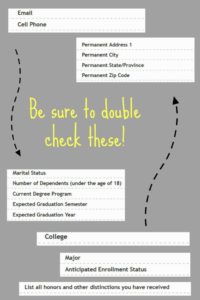 2) Double Check:
2) Double Check:
The “Double Check” category is for those areas that may or may not need updating. For example, have you changed your major since the last time you submitted an application? Have you transferred schools, had a child, changed your marital status, or received a new award? If you answered “yes” to any of these, then you have some updates to make! Once again, this is just a guide and not intended to be an exhaustive check list. It is important to carefully look through your entire application to ensure that it reflects your most recent academic and personal journey.
 3) Update:
3) Update:
The “Update” category includes the sections that are either required or strongly encouraged for updating. The “Cumulative GPA,” for example, needs to be updated every time an application is submitted. Additionally, your year in college needs to be updated as you accumulate more credit hours.
The short-answer questions and thank-you components should be updated to best reflect your educational journey. For example, as your education continues, how have your goals or dreams developed? Have they changed or solidified in any way? If so, how?
For the thank-you portion, how has the scholarship funding you have received in the past helped you get to where you are today? How has it positively influenced your academic and personal goals? These answers will better shape your short-answer questions and thank-you portion and allow our readers to grasp a better understanding of your educational journey overall.
Remember, this application tip is not intended to be an exhaustive checklist for returning applicants but rather to assist you through the re-submission process each year or semester. As always, feel free to contact the SSS team with any questions!
Full Circle Scoring Insights
You’ve spent hours perfecting your application and endless nights editing your short answer questions, and you’ve just received the confirmation email of submission. What happens now? Where does this elusive Full Circle application soar in cyberspace, who reads it, where are they, and what are they looking for?
First and foremost, when you hit the ‘submit’ button on your application, it is stored securely in the online application system until scoring begins in mid-May.
To ensure the highest quality of readers, we invite eight to ten higher education professionals from around the country to take several weeks out of their summer to evaluate the applications. The majority of these readers are American Indian. College Fund staff members do not score the applications.
For scoring consistency across the applications, all readers use a rubric system to determine how many points to allocate for various portions of the scholarship application; higher scores are more likely to receive a scholarship. The rubric scores content, fluency, and technical conventions of the three short-answer questions. Applications with higher GPAs, extracurricular activities, and honors and distinctions are also desirable, and there is a preference for tribal college students and alumni. The final score is determined by averaging the numbers from multiple readers on each application.
Readers finish all applications by mid-June, and this is when the awarding work begins. For the rest of the summer, the Full Circle Program Manager and the SSS Team work to award students with high scores who match various scholarship requirements. With more than 50 different scholarships programs under the Full Circle Scholarship Program umbrella, it takes a long time and patience to match eligible students with donor requirements for scholarships.
Typically, scholarship awards are determined by mid-July; however, you can log in to your online application profile at any time to see if you have received an award. If the word “pending” appears beside the application, that means your application is still under review, so keep checking back!
We hope this has been helpful in outlining how scholarship applications are scored. As always, if you have any questions or concerns, please feel free to contact us by email or at 303-426-8900.
If you have additional questions about applying for scholarships, be sure to read through our Frequently Asked Questions.


